Back in April 2014, the WR wrote up a napoleonic scenario for the small engagement Battle of Gilly June 1815. This rearguard engagement had the Prussian 2nd Brigade, after a long day of marching and fighting off the French fast marching columns, turning to delay once again the French Army right flank advance, thus allowing the Prussian 1st Korps to collect at Fleurus (near Ligny) that late evening. Prussian 1st Korps already had its 3rd, 4th and most of reserve cavalry brigades near Fleurus (except 6th Uhlans), The 1st Brigade, with 6th Uhlans (ex Lutzow’s) nearby, was disengaging from their action on the Charleroi to Quarte Bras road thus leaving the 2nd Prussian Brigade the remaining task of slowing the French right flank forces under Emperor Napoleon with escort, plus GD Vandarmme (2nd Corps), GD Pajol (1st Light Cavalry Corps) and GD Exelmans (2nd Reserve Corps).
Link to Gilly June 1815 scenario write-up: Battle of Gilly 1815 scenario.
Scenario play test report and AAR (1st game): Gilly 1815 was played by John (Prussians) and WR (French). John volunteered himself the hard task of playing a rearguard action and withdrawing before massive French infantry columns and lots of French cavalry, including a detachment of OG Empress Dragoons. To make his life more of a challenge he was without his senior Prussian Korps commander (General Zieten II) off table all evening and faced with the French man of the hour in charge…. Emperor Napoleon. Tough job… but John was up for the challenge of play. Plus he had never used Prussians before too!
After deploying the starting units on the tabletop per the Gilly 1815 scenario notes, the French opened the scenario with a fast marching (or riding) advance. This is a scenario of speed, to cover the distance across the tabletop and catch the equally determined to “leave the area” 2nd Brigade Prussians.
French 4th Light Cavalry division came forward on the French left flank. The French 11th Division formed the center around Gilly village with the OG Empress Dragoons just to their right. Emperor Napoleon with his OG Empress Dragoon escort squadron was near the monument (WR was lacking his windmill for scenario game) and the 9th Dragoon division formed on the right flank. Prussians had three squared battalions of infantry (6th and 28th IR), screened by the 28th Fusiliers plus their brigade battery on the roadway behind Gilly village. The 6th Fusilier battalion held the Prussian right flank woods, backed by a battalion of the 28th IR in the Abbey of Soleilmont. Entering the left Prussian flank was the 2nd Dragoons (Queen’s) regiment. Lastly the brigade’s landwehr regiment (2nd Westphalian) and the Westphalian landwehr cavalry regiment was marching up the road towards Fleurus. Specific deployment information is written in the linked Gilly 1815 scenario notes document (.doc).
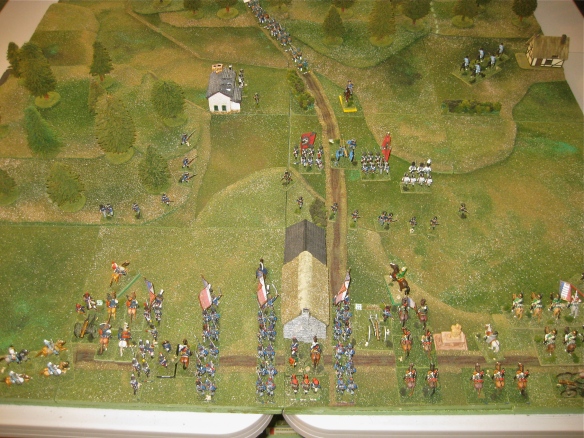
Opening 1800 hours deployment and situation facing the Prussian 2nd Brigade as the French under Napoleon have arrived (lower right). The 4th Light Cavalry, 11th Infantry, and 9th Dragoon divisions (l to r). All photos can be clicked on and enlarged.
Emperor Napoleon’s arrival and direct orders to GD Vandarmme had energized the French Army into action as he noticed the beginning retirement of the Prussian 2nd Brigade infantry. Both sides were “bone tired”* from the long day of marching and many small engagements along the Prussian 2nd Brigade’s retirement path.
* Note: This is reflected in the MFP usage and starting values. The Prussians have little reserve MFP left (only 22 left out of 52) and must prevent losing or using MFP too fast for the 1st hour of the scenario. During this scenario play test John went over his 52 MFP on the starting 2nd game turn hour and thereby started automatic -1 CMR every hour. The impact was dearly felt later in the scenario. The French are in the same situation, but with a large army present they have great MFP endurance and only exceeded their 200 MFP value (112 at start, 200 total) on the 10th and final game turn mainly due to the copious use of Attack divisional orders. More on the MFP rules here: Morale Fatigue Points (MFP)
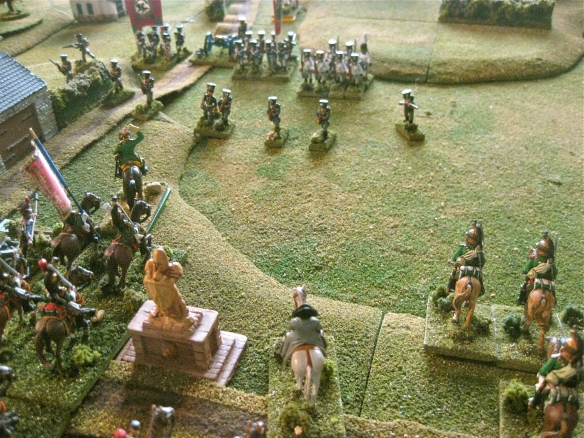
Emperor Napoleon arrives and orders the attack to commence immediately.. General Letort leads the OG Empress Dragoons forward at left. The monument stands in for the windmill today.
1800 hours: The French waste no time. Infantry columns of tired men somehow stand to, form up, and advance down the slight hill slope cheering within the sight of Napoleon. Artillery batteries push their horses to deploy their battery cannon while the French cavalry divisions trot forward and sound their trumpets. Seeing the French cavalry, Prussian skirmishers quickly retire behind the steady Prussian squares as Prussian 6lb cannon balls bounce among French ranks.
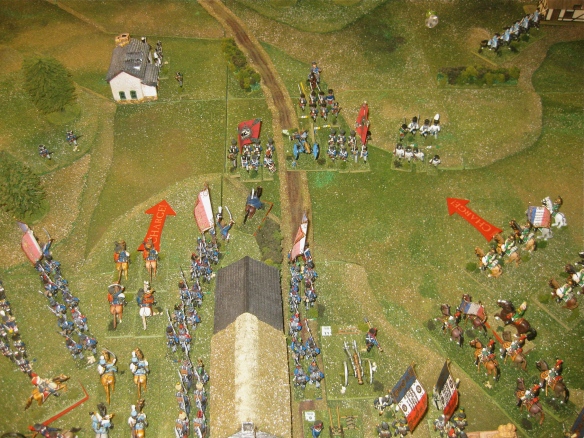
1800 hours. Opening French movements done, exchange of artillery fire and the French trumpets sound the charge. The 4th Light Cavalry division at left (4th hussars) and the 9th Dragoon division, supported by OG Dragoons, at right.
With French trumpet sounds in their ears, the steady Prussian infantry squares brace themselves for the French dragoon regimental charges. Their 2nd Queen’s Dragoon regiment wheels into line and countercharges down the slope into the startled leading French dragoon regiment.
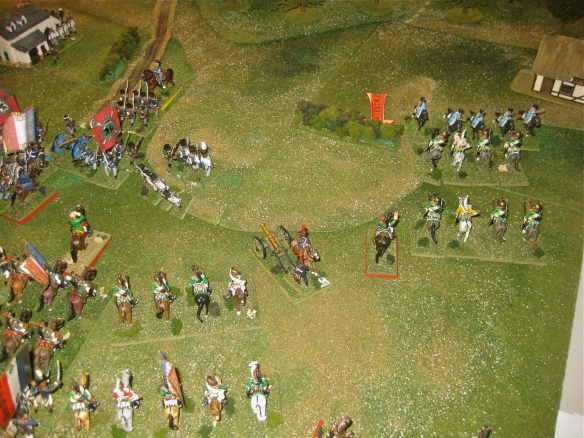
1820 hours. The Prussian 2nd Dragoons regiment counter-charges forward to engage the advancing French dragoons while the Prussian squares are under artillery bombardment.
The odds against the Prussians rapidly rose as the 2nd echelon of divisional commands entered the tabletop right behind the forward French divisions. 5th Light Cavalry division arrives and rides towards the open Prussian right flank. 10th Dragoon division rides forward behind the 9th Dragoon division heading towards the Prussian 2nd Dragoons on the hill. 8th Infantry Division marches on behind and to the right of 11th Infantry division. The French mass have doubled in size on turn one with Emperor Napoleon directing.
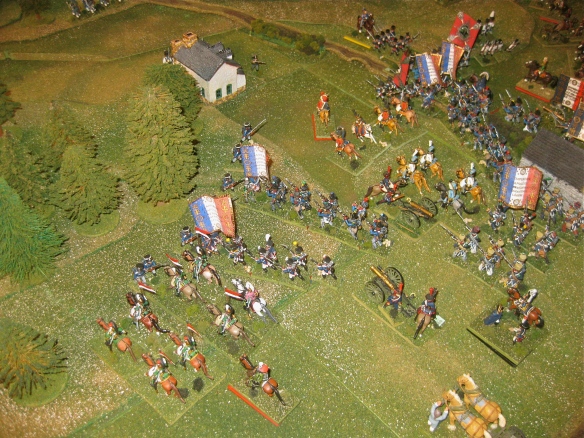
1820 turn French movement done. The French left flank advance into contact again pressuring the Prussian 6th IR fusilier battalion in the woods. 5th French Light Cavalry division has arrived.
First charging French dragoon regiment coolly repulsed by the Prussian bayonets, their second dragoon regiment pulls up short after trotting forward 200 yards*. “Lets let the artillery cannon work on those Prussian squares” thinks the dragoon regimental commander. Meanwhile the Prussian 2nd Queen’s Dragoons scattered the leading French dragoon regiment below the hill slope but stopped short of engaging the fresh French dragoon regiment standing behind.
* Note: Cavalry unit which calls a charge or counter-charge must movement forward 4″ minimum distance or fight in a shock combat to fulfill the charge movement requirements.
1820 hours: The French left flank infantry columns, along with the just arrived 5th Light Cavalry division regiments, entered the Bois de Lobbes and started the long running fight with the skirmishing Prussian 6th Fusilier battalion. For the next several turns of play, the Prussian 6th Fusilier held the French advance by firing then retiring the minimum 4″ distance* of skirmishing.
In the center of the battlefield below Gilly the French 11th Division, backed by the arriving 8th Division, chase the retiring Prussian infantry squares. French artillery is pounding the Prussian squares with losses while French cavalry lurks nearby. A French cavalry charge is sounded by the OG Empress Dragoons to slow the Prussian infantry retirement** and successfully morale disrupted the Prussian brigade 6lb battery crew.
On the right flank the French Dragoon divisions advance and prepare to charge the solo Prussian 2nd Dragoon regiment.
* Note: Every time the Prussian Fusilier battalion retreated before the French shock columns, the French leading miniatures fired a doubled musketry volley at the skirmishing open order Prussian infantry. Being a skirmish formation and under medium woods cover the calculated fire effect was very low percentage for Prussian miniature loss. But if the Prussian player (John) retired his fusilier miniatures from French shock combat they had to clear the maximum musket range (4″) on the tabletop before turning around and presenting a new skirmisher line position. Hence every turn the Prussian movement was to back up 4″ in the woods, taking low chance French volleys every turn of retirement movement. The other thing to note is the French Shock Phase is after the Prussian Movement Phase thus the Prussian player have options before the actual shock combat is performed.
** Note: Movement in a declared cavalry zone is performed at half speed. A charge zone depth is equal to the basic movement of the cavalry unit (12 to 16″ depending on type) and has a 22′ off angle on each side. The French tabletop tactic was to charge, bounce off the Prussian square impacted but cause all the Prussian infantry in the charge zone to move at half speed during their next movement phase. French Declare Cavalry Charge phase is before Prussian Movement phase in our sequence of play. Sequence of Play Standup
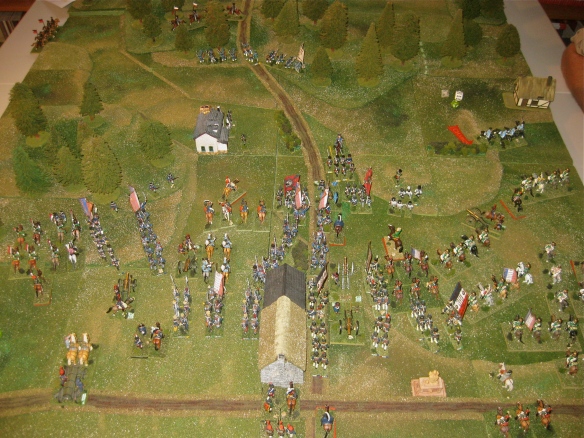
1820 hours overall view. French half of turn is done. Prussian turn half next as French advancing to engage the Prussians. OG Empress Dragoons prepare their pinning charge.
Prussian 6th Fusiliers retire backwards on their right flank. In the center the hard pressed Prussian infantry squares, bombarded and taking losses from cannon fire, charged by the OG Empress Dragoons, retire their 2″ movement. The Prussian 2nd/6th IR square protects* the morale disorder Prussian 6lb battery while the retiring 28th Fusilier battalion reaches the protection of the rearward woods. The OG Empress Dragoons impact the Prussian 1st/6th IR battalion and, after a short fight, breach the protective wall of bayonets. Heavy swords and desperate Prussian infantry bayonets. A quick roll on the “ride thru” table*…. a 2 is rolled (d6). Two more Prussian miniatures bite the earth as the survivors flee for the nearby rearward woods. (Historically the Empress Dragoons ran over a Prussian square at Gilly).
* Note: When cavalry cause infantry or artillery crews to retire or rout, the cavalry Ride Thru Table is consulted. Dice roll modifiers in this case were +1 for heavy shock bonus weight cavalry and +1 for officer-commander attached. Count the number of front rank cavalry miniature (three) and half (RD) the following ranks (one more). So four OG Empress Dragoon miniatures with +2 to d6 roll. Chopped down two more Prussian miniatures.
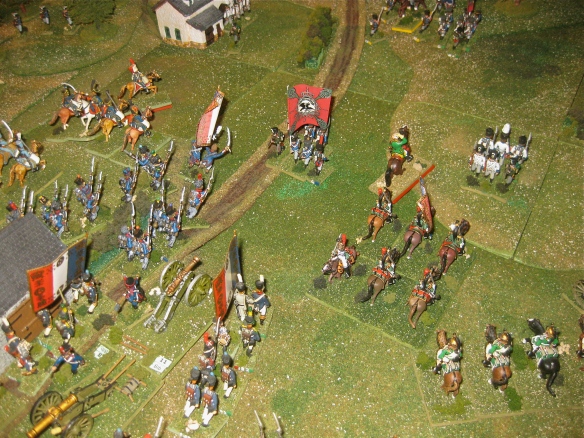
French OG Empress Dragoons charged a short distance during the Prussian 1820 hours turn and crushed the 1st/6th square. Prussian battalion squares under artillery bombardment and taking heavy losses.
With one Prussian square crushed and survivors routing, two other exposed Prussian squares pounded by French artillery, the French infantry / cavalry advance up the center is grinding away the Prussian defense. French 9th Division dragoons charge and chase away the Prussian 2nd Queen’s Dragoons, chasing them to the woods path entrance (green chalk dotted line on woods felt). Only the valiant Prussian 6th Fusiliers are holding up the French general advance without losses. The Prussian 6th Uhlans (ex Lutzow) arrive because the French Player (that’s me – bad rabbit) decided to enter the left “A” row of map squares (see scenario map), thus triggering Prussian reinforcement of the 6th Uhlans. The retiring Westphalian landwehr battalions (3) have taken up positions along the distant Bois Tricheheve edge along with the Westphalian landwehr cavalry regiment.
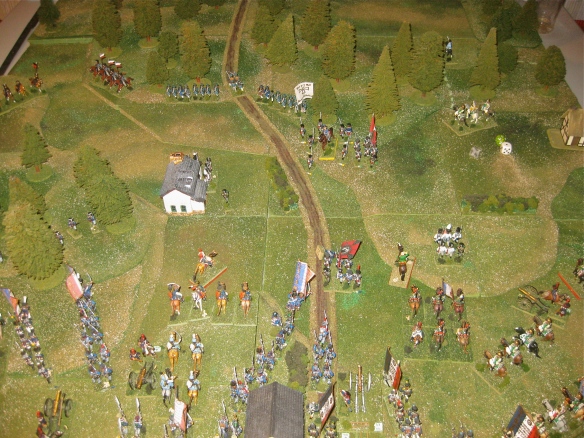
Prussian squares slowly withdraw as a French dragoon regiment chased away the Prussian 2nd Dragoons. 6th Prussian Uhlans (ex Lutzow) arrive upper left while Westphalian landwehr line the woods edge.
1840 hours: More of the same. 6th Prussian Fusiliers slowly giving ground in the Bois de Lobbes as some French chasseurs a’ cheval work around their open right flank (5th LtCav.). While the retiring or routing Prussian battalion rally at the Bois Tricheheve edge, the remaining two exposed Prussian squares are pounded by French artillery fire. The 2nd/6th IR battalion is blasted open and the remains flee to the safety of the Bois Tricheheve to later rally along with the 6lb battery crew (abandoned their cannon). French hussars (4th LtCav.) are passing the garrisoned Abbey de Soleilmont while the French infantry column continue their forward movements. On the French right the two dragoon divisions reform their ranks and prepare to transit the Bois Tricheheve.
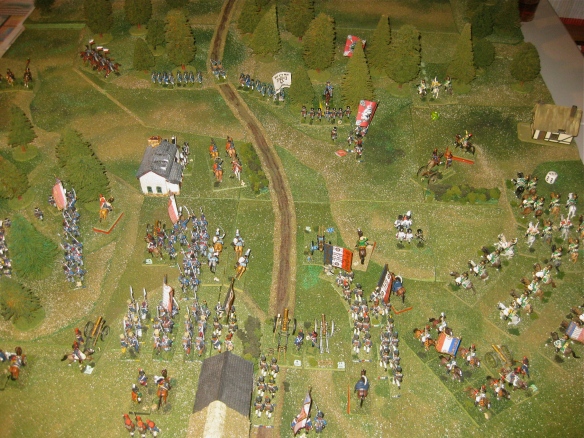
1840 hours French turn done. One Prussian square morale breaks taking the Prussian artillery crew with them while the other grimly is bombarded.
1900 hours: Bold French movement by the 5th Light Cavalry division has their leading 11th Chasseurs a’ cheval regiment exiting the Bois Ransart only to come face to face with the formed ranks of the 6th Uhlans. Promptly charged, the French divisional commander Subervie joined his chasseurs and fought off the determined Prussian uhlans. French 11th Division infantry columns assault (shock) the Abbey de Soleilmont defended by the 2nd/28th battalion. Pushing aside the pulped remains of the 1st/28th battalion, the French 8th Division approaches the central Bois Tricheheve edge along with the 4th Hussars. Artillery batteries have limbered up and drag their cannon among French columns. Linear Prussian Westphalian landwehr hold their ground watching the French advance along with their rallied 2nd/6th battalion and Fus/28th battalions. But the Prussian left flank is wide open for French dragoon regiments to enter and freely transit the Bois Tricheheve. The bad news keeps coming for the Prussians as they have exceeded their army morale fatigue level (MFP) so commencing the hourly -1 CMR* stepped reduction process.
* Note: Minus one CMR for 1st hour over, minus 2 the second hour, minus 3 on the 3rd hour over etc…. soon the Prussian battalions cannot pass even basic morale checks and will break / rout their battalion when pressured. Once an army exceeds their MFP level, the battle is over and the army must seek to retire from the battlefield before lasting damage is done from morale failure unit testing. The CMR adjustment is both morale and shock combative.
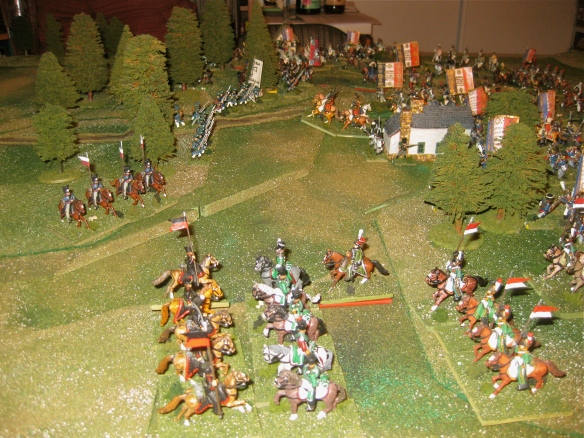
1900 hours. The French 5th Light Cavalry exit the left flank woods and are counter-charged by the Prussian 6th Uhlans (ex Lutzow). Westphalian landwehr cavalry looks on as the Abbey de Soleilmont is assaulted behind the trees.
Quick assault eviction of the 2nd/28th battalion defenders of Abbey de Soleilmont is performed by two French columns. The shaken retiring defenders pass the steady Westphalian landwehr battalions lining the Bois Tricheheve edge. These Prussians are still full of fight…. battalions are rallying and placing themselves along the woods edge.
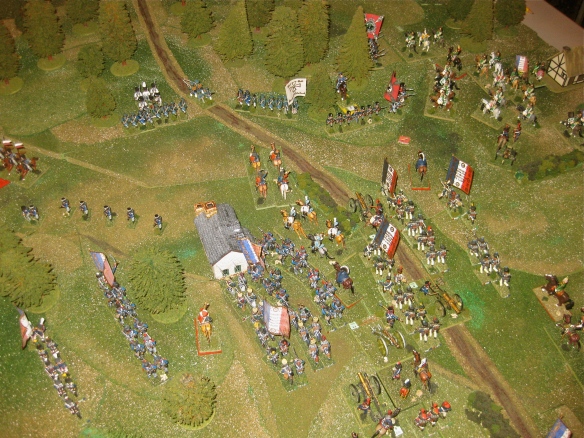
1900 hour turn completed. French have taken the Abbey de Soleilmont while 9th Dragoons division approaches the upper right Bois Tricheheve. The last exposed Prussian infantry square was destroyed.
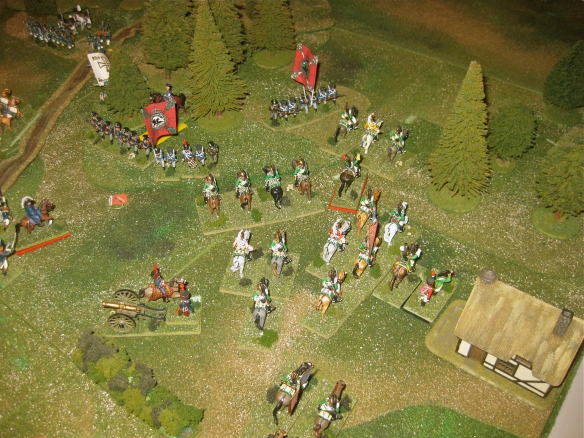
The French 9th Dragoon division has arrived before the woods. The rallied 6th IR battalions seek to stem their advance along the “chalked trail”. French 10th Dragoon division just off photo.
1920 hours: French 8th Division infantry columns crash into the Prussian defensive linear formation along the center Bois Tricheheve edge. The French 4th Hussars attempt to trot their linear line of horses into a Westphalian landwehr battalion (cannot charge in the woods*). After chasing away the 6th Uhlans, the French 11th Chasseurs a’ cheval themselves are charged and routed by the Westphalian landwehr cavalry while French lancers look on.
* Note: Normally cavalry is not allowed in medium woods for our typical scenarios. For this Gilly scenario the open and cleared undergrowth woods were treated as medium woods (not light woods) with special rules for formed or open order cavalry movements.
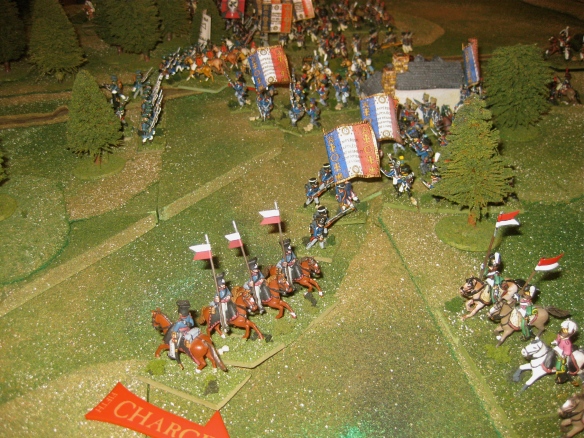
1920 hours. While the French infantry and cavalry advance in the distance, the Westphalian landwehr charge and chase away the exposed French chasseurs a cheval regiment (5th Light division) as fresh French lancers look on.
1940 hours: After some French columnar success along the central Bois Tricheheve edge, French infantry columns advance deeper into the woods. Even the crazy 4th Hussars won their fight and pushed back the Prussian Westphalian landwehr battalion. Out on the French left the French 11th Division impacts another Westphalian landwehr battalion while the retiring skirmishing battle with the 6th Fusiliers continues.
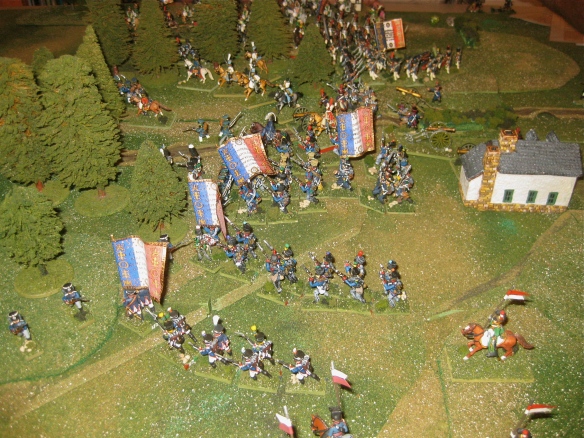
1940 hours has the French infantry advancing to the attack in the center. Prussian resistance weakened as some French hussars enter the woods.
General view of the tabletop action midpoint 1940 hours. French infantry battling in the Bois Tricheheve while French both dragoon divisions transit the open Prussian flank. OG Empress Dragoons advance to exploit a Prussian battalion gap.
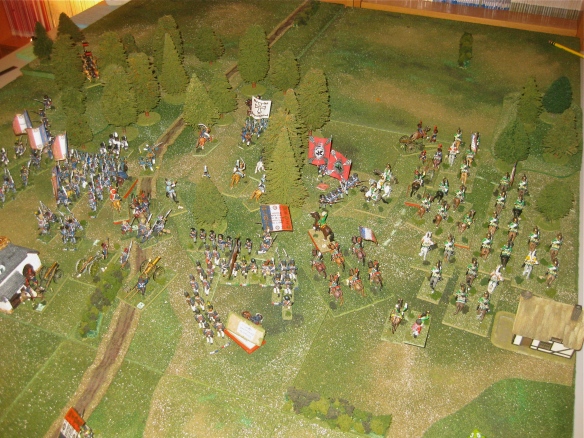
1940 hours shows the French infantry and dragoons advancing into the Prussian defensive wood position. OG Empress Dragoons seek to exploit a possible Prussian gap.
After the French assault (shock) combats, the majority of the Prussian battalions are in a state of morale disorder retirement. Seems little to stand in the way of victorious French advance.
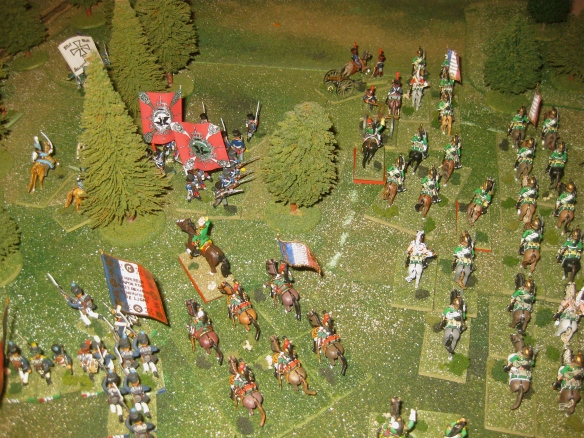
French OG Empress dragoons seek opportunity to attack the Prussian infantry while both the 9th and 10th Dragoon divisions struggle though the woods with reduced movement.
2000 hours (dusk): Prussians just don’t want to give up this action even with a -2 CMR morale adjustment for current army morale. They rally again and form another shaky battle line with their depleted battalions. Hard to see among all the free-standing tree miniatures and blue French coats but they are there. The 6th Fusiliers are still retire skirmishing before the advance French 11th Division columns… even causing the occasion French miniature loss.
2020 hours: As French dragoon regiments break in the open ground beyond the Bois Tricheheve, triggering the arrival of the Prussian 1st Reserve cavalry brigade, the tired French infantry struggle to maintain their assaults against the shaky Prussian defenders. Losses are mounting with the 8th Division near 20%* miniature loss.
* Note: Morale CMR -1 at 20% loss level (of miniatures). At 40% CMR -2. At 60% the adjustment is -3 morale adjustment. In most cases commands at 40% loss level are ineffective for the remainder of the scenario battle unless elite formations. Units with their army over the MFP level suffer addition CMR adjustment,
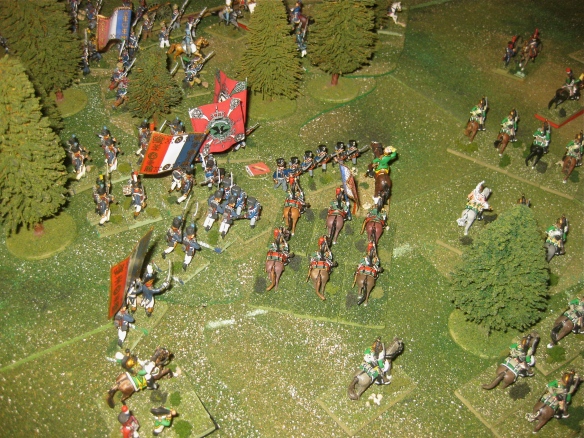
2020 hours. Empress dragoons held up while French infantry columns assault the Prussian battalions. The Prussians somehow have closed the gap in their line.
French assaults go in… the Prussian morale fails to hold and several battalions retire or rout long before the bayonet crossing shock combat action. The Prussian infantry basically has had it for the scenario so they retire quickly to the protection of the recently arrived Prussian 1st Reserve cavalry brigade. French dragoon regiment seek to deploy before the Prussian cavalry and French horse artillery open fire on the new arrivals… “welcome to the engagement fellows”.
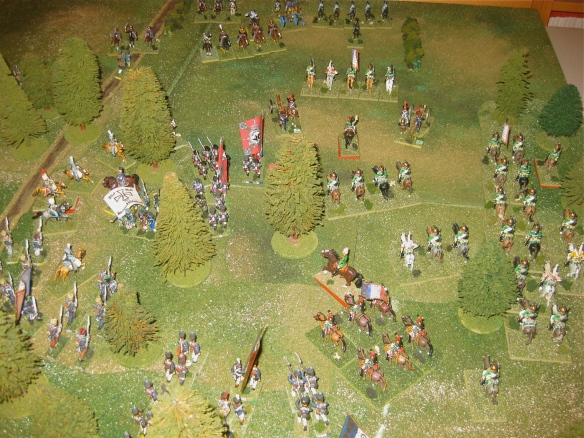
2020 hours has the Prussian battalions retiring from the French column assault. French dragoons have exited the Bois Tricheheve bringing the Prussian 1st Korps Reserve cavalry to the battlefield.
The 6th Fusiliers are still doing the masterful retirement skirmisher action as several Prussian infantry battalion fail to rally.* Overview of the battle as the Prussians are leaving the battlefield.
* Note: Units have two morale rally attempts. Failure of the 2nd rally attempt causes unit removal and counts towards losses for MFP calculations.
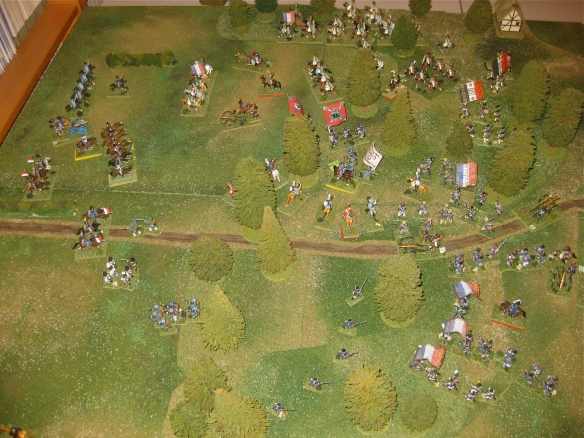
2020 hours. The view from the French left flanks showing confusion of the battle as the Prussian cavalry arrives at left.
2040 hours: Isolated Prussian battalions remain on the battlefield, others fail to rally on their 2nd attempt and “poof” away as the evening dusk descends into dark night. The action of charge and countercharge cavalry regiments marks the last visible daylight of June 15th. French massed dragoons vs. Prussian dragoons, uhlans, and landwehr cavalry. The French dragoons are victorious and sweep the Prussian cavalry into retreat, taking their 6lb horse battery along the way as a trophy.
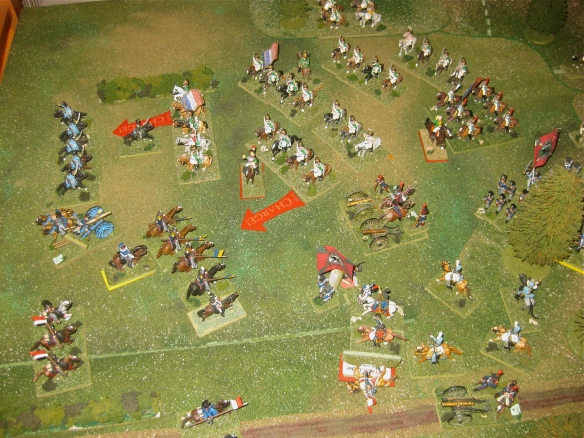
2040 hours. The French 9th and 10th Dragoon divisions exit the Bois Tricheheve and seek to charge the Prussian Reserve cavalry regiments. OG Empress Dragoons looking pretty.
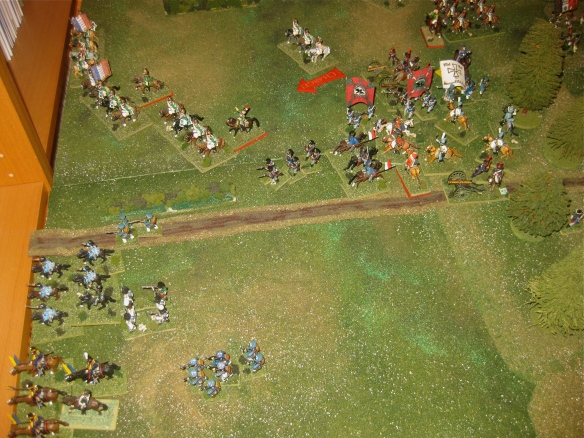
After the back and forth of the cavalry charges, the French dragoons are victorious in combat. Prussians are in general retirement now.
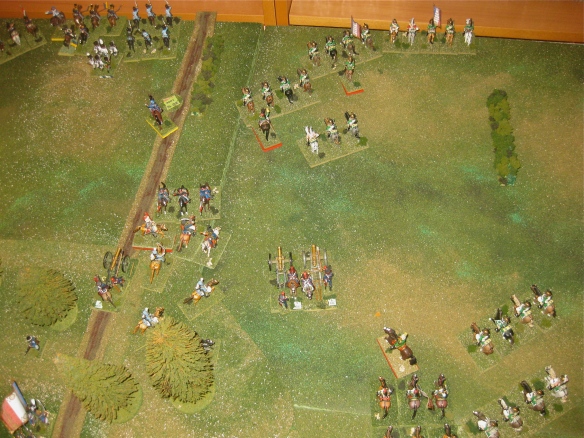
The battlefield seems deserted of Prussians as several Prussian battalions fail to rally and scatter from the battlefield.
2100 hours (scenario end): The French army finally exceeded their MFP total so all units go down one CMR and every Attack order is changed to Engage orders. But they have won the scenario in principle as the Prussian 2nd Brigade and Prussian 1st Korps reserve cavalry retire from the battlefield.
Summary: Emperor Napoleon has won another minor action the day before the historical Battle of Ligny on June 16th. Only the French 11th Division suffered over 20% miniature losses. The 9th Dragoon and 4th Light cavalry divisions almost suffered 20% loss level. For the Prussians the 2nd Brigade was wrecked at 60%+ and their late arriving reserve cavalry took a quick 15% losses. Two Prussian artillery batteries taken in the fighting.
Overall the scenario ran somewhat to historical events. Per the victory conditions the French won a “draw victory” result edging towards a French major victory. This was mainly due to 2nd Brigade 60%+ losses, except the French cavalry couldn’t muster two complete cavalry divisions (less their horse artillery batteries) to exit the battlefield on turn 2120 hours. John and WR had some scenario design discussion afterwards and those changes noted below. WR also updated the scenario notes document (.doc file) below to reflect the minor changes discussed.
Thank you John for play testing this difficult withdraw scenario. Withdrawing scenarios are always the hardest to write and play balance. They truly test a player’s ability when faced with the scenario task and unit tabletop management. Recently WR wrote up his Battle of Wertingen 1805 scenario, again a form of rearguard action but this time with Austrians.
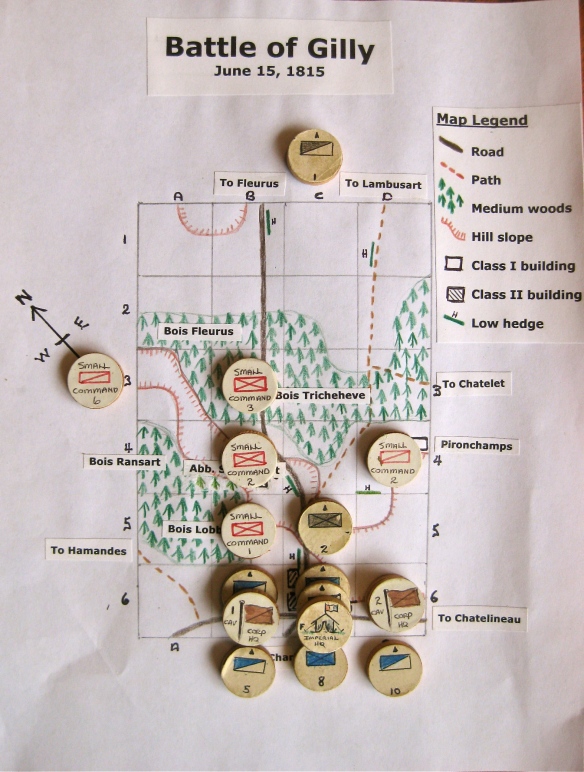
Battle of Gilly June 1815 scenario map with starting position map counters. See scenario notes for details. Click on to expand. A clear map without map command counters in scenario notes.
Some document files taken from the previous blog post on Gilly 1815. WR’s Gilly updated scenario notes (.doc): Gilly 1815 scenario notes, the French roster (.xls): Gilly 1815 French roster, and the Prussian roster (.xls): Gilly Prussian roster
WR has posted written rules documents, charts, and video material on the Napoleonic games. All linked to the Wargamerabbit blog page and YouTube: Napoleonic rules and You tube videos.
After play testing the original Gilly 1815 scenario notes with John and linked above, WR and John discussed the scenario and agreed to some minor changes. These changes have been included in the updated scenario notes file.
1). Changed the radius distance deployment for the Prussian infantry battalions near Gilly village from 8″ to 12″ from Gilly.
2). Deceased the speed of cavalry movement in the woods. Originally 4″ movement cost, now 6″ movement cost for closed order cavalry and maximum 10″ movement for open order skirmishing cavalry formations.
3). Word changes to the victory conditions to clarify victory outcomes.
To test these charges, WR two days later played a solo Gilly 1815 scenario wargame, following the same general movement tactics of the original play test game. The outcome was different and close to the historical result. The scenario turn by turn summary video is linked to WR’s YouTube account. There are four (4) YouTube segments.
Gilly Part I: Covers opening deployment and turns 1 to 2.
Gilly Part II: Covers scenario turns 3 to 5
Gilly Part III: Covers scenario turns 6 to 9
Gilly Part IV: Covers scenario turn 10 and game summary
Thank you John for playing in WR’s monthly game at the warren. Each month WR tries to run one small napoleonic, or COE ancients, or 20mm Flames of War scenario on his gaming table. If anyone is interested, let WR know and I will include you on the invite email broadcast list. First come, First playing setup as the games are limited to four players (5 counting WR).
Last notes… Scenario playing time for the 1st scenario game with John and WR was about 4 hours and some light discussion afterwards. The 2nd video scenario game played in 5 hours but that includes all the video commentary time too. Sorry John if I took a lengthy time moving all those Frenchmen but not bad overall for one player in either game commanding six separate French divisional infantry or cavalry commands.
Cheers from the warren.
WR
PS. Two additional photos of the combatants…… John and WR at the table.

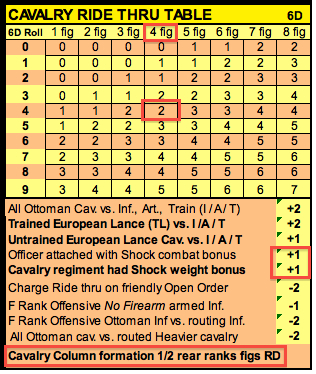
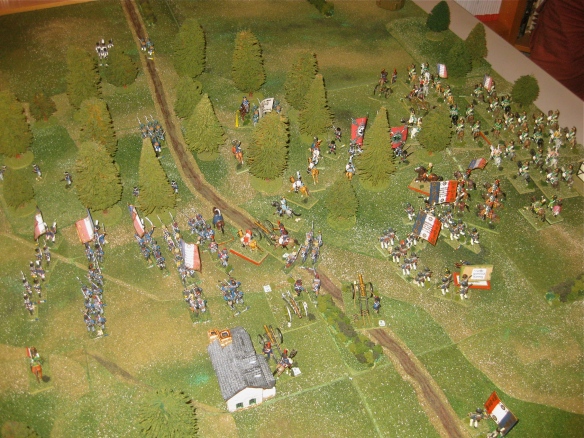
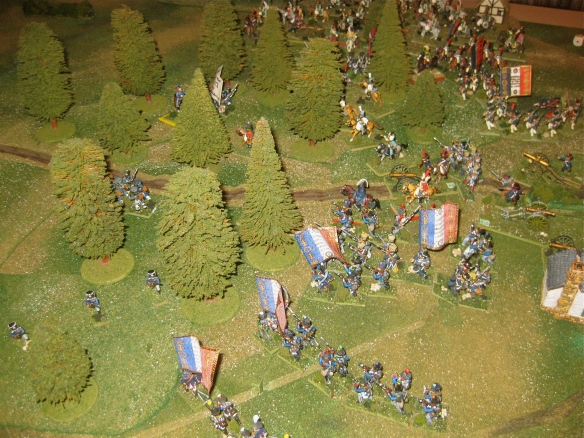
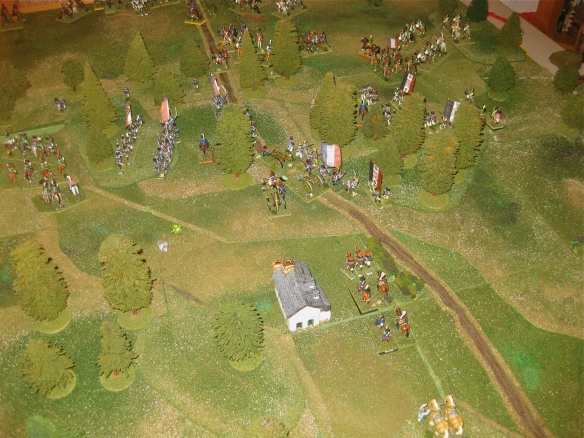
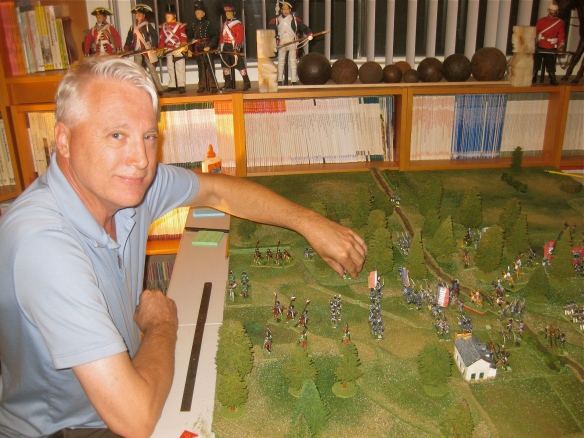
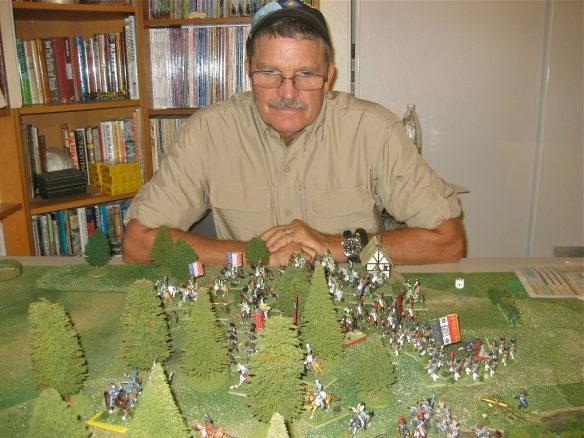
No question that scenarios of this kind are difficult to design and balance. They weren’t easy for real life commanders to pull off either. Some did it better than others, to be sure!
I agree Peter. Tough to balance out scenario with horribly uneven forces and miniature movements on the tabletop. Seems this one worked out ok, especially after the minor discussed changes with John. Also posted a WR photo taken during the action from John.
M
Didn’t kinow anythingabout this batttle! Nice looking game, this table is really beautiful, great report!
Hi Phil. Thanks for stopping at the warren. Gilly is sort of a unknown action, quickly grossed over by the big three battles (QB, Ligny and Waterloo). Gilly did have some effect on the Prussian evening of June 15th deployment…. without the 2nd Brigade’s slowing the advancing French right flank, the French would have been in Fleurus hours earlier and disrupting the nearby Prussian concentration for June 16th (Ligny).
M